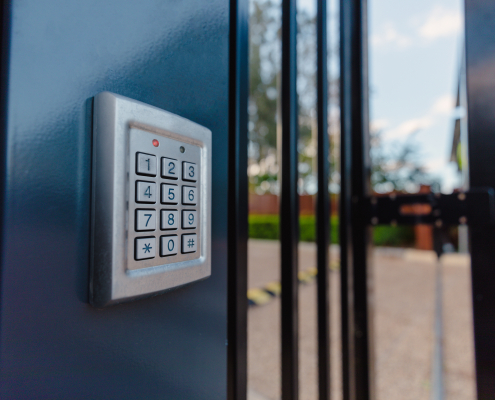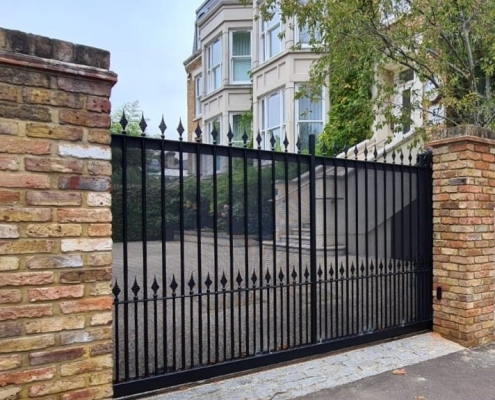Automatic Gate Safety
When it comes to automatic gate safety, badly designed or installed automatic gates have the potential to cause significant injury. Like cars or any machines we use regularly every day, there are dangers. But we know how to look both ways when we cross the road or not to drive too quickly in the wet. Modern cars also have airbags and anti-lock brakes.
Gate automation safety is the same. If you don’t know how to use it safely and it’s not built with safety features, it could be dangerous.
If you are looking at your first automatic gate system, there are risks you need to know about. So this article gives you an outline of what to look for and how to make sure you have the right installer.
How Do You Make Automatic Gates Safer?
Automatic gate systems are made when a gate or a pair of gates, automation equipment and other accessories such as safety devices, locks and access control systems are assembled together. This automatic gate installation creates a new ‘machine’ from these elements. And this new machine needs to be as safe as possible.
For most domestic installations, gates swing or slide open and closed. This creates a number of potential risks. These risks are based on how each gate moves in relationship to gate posts, other gate leaves, fences, walls and railings.
You can ensure you end up with safe automatic gates. First, carry out a safety audit to identify the potential risks.
A good safety audit should look at how to:
- Physically remove the different types of risk
- Physically prevent access to risk areas
- Educate users to the potential dangers and how to avoid them.
Unfortunately, there are times when a gate will be used or approached by people without knowledge of the risks and how to avoid them. In these case it is always best to prevent physical access to the risk areas.
Electric Gate Safety Directives, Guides and Recommendations
There are British Standards (BS) that describe the minimum requirements for a safe automatic gate system.
These include:
BS EN 12453:2001 which recommends a minimum level of safeguarding against the crushing hazard at the closing edge of the gate depending on the type of environment in which the gate is operating. The Standard defines 3 types of use:
Gate Use Type 1
The gate is only used by trained users and there is no intended, inadvertent or unauthorised access to it by members of the public.
Gate Use Type 2
A limited group of persons (for example persons sharing a block of flats) are trained to operate the gate and the gate is located in a public area.
Gate Use Type 3
Any person is free to operate the gate and the gate is in contact with the general public.
Recommendations for the minimum levels of safeguarding based on how the automatic gates will be used include the following:
As Type 1 gates are controlled and operated by trained users, they are not covered in this safety notice because the gates are not located in the vicinity of the general public.
But Type 2 or Type 3 gates with automatic controls are accessible to untrained individuals who may not understand the possible risks. They could, therefore, find themselves close to the risk areas of an unsafe gate. So the Standard gives advice on the level of safeguarding as follows:
- The forces that operate the gate leaves must be limited using force limitation devices or sensitive protective equipment
- Provide ‘obstacle detection’ that recognises the presence of a person or an obstacle in the area the gate moves through.
Automatic Gate Safety And The Machinery Directive
The Machinery Directive describes what the installer needs to do to create a new piece of machinery. This covers the paperwork and CE marking that you should receive from a good gate automation installer.
So what are the main considerations for the design of safe automatic gates?
One of the most important considerations is the weight of each gate leaf. A heavier gate needs a stronger force to open and close it. But this doesn’t just mean the force needed to overcome the inertia of the gate itself. The gate will be affected by air pressure on its moving face and this can vary greatly depending on the speed of any wind blowing towards a moving gate.
Increase the force required to move a gate and you increase the potential force passed to anything that moving gate comes into contact with.
How Different Gate Motors Affect Electric Gate Safety
Gate automation motor choices are also important. You need less force to push the gate open from as far from the hinge as possible. Ram motors and articulated arm gate motors push and pull the gate further from the hinge than underground motors. This means that they require less force to move the same gate than an underground motor does.
Articulate arm motors also present a risk due to their design. The articulated arm creates a gap between itself, the gate post or pillar and the closed gate. As the motor closes the gate, this gap disappears between the motor arms.
The hinge end of swing gates creates a gap between the gate and the post. It’s important that his space isn’t big enough for anyone to put their arm or leg through. This is because the gap between gate and mounting closes up when the gate opens.
Sliding gates with gaps in their design can create risks if they slide open against railings. The leading edge of a sliding gate can also create risks where it slides past posts, pillars or edges of walls etc.
Any safe automated gate system should include a manual release system. This lets you disconnect the motors so you can move the gates by hand. Anyone who operates the gates should be taught how to use the system and where you keep the manual release keys.
Automatic Gate Safety Risk Assessment
Your gate automation installer should deal with all the potential risks with a thorough safety audit. This looks at each potential risk in conjunction with how the gate will be used.
Your installer should bring the proposed gate design, choice of gate automation system and user knowledge together. They should then apply the Standards and recommendations to design a safe gate automation system for you.
Typically, a thorough risk assessment answers the following questions:
How will the gate be used?
What the potential risks throughout the lifetime of the system?
How dangerous each potential risk is and what is done to mitigate that risk?
Answer these questions and you can prioritise the risks. The installer then deals with them as follows:
a: The risk is eliminated or reduced by the design of the gate automation system.
b: The risk is reduced by the application of safety devices added to the system.
c: Where it is not possible to incorporate a or b, warning signs and safety instruction are provided clearly for all users of the electric gates.
d: Measures for fast and safe release from the hazard are incorporated.
Final Thoughts On Automatic Gate Safety
A gate automation system can be dangerous if designed and installed by unqualified, inexperienced or uncaring gate automation engineers. However, safe automatic gate systems are installed every day all over the world by professional installers.
When you’re looking for a gate installer, use this article to help you to ask them questions about gate safety. Make sure you have an installer who understands the risks, talks to you about your use of the gates and applies the recommended risk prevention measures.






